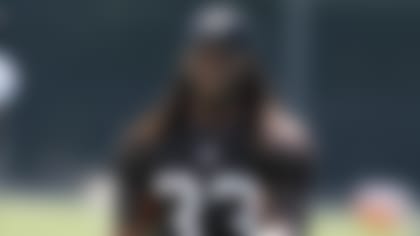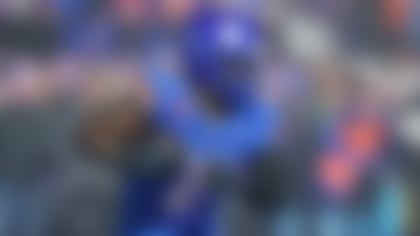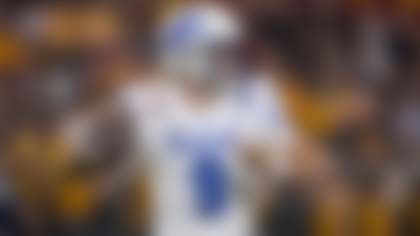One of the jobs of a general manager is to put together contingency plans to handle the injury setbacks that routinely occur during the preseason. Although executives hope to avoid these situations, a carefully constructed course of action could be the difference between a playoff berth and a disappointing season.
Let's take a look at how some teams are dealing with the loss of key personnel due to preseason injuries:
Trent Richardson, RB, Cleveland Browns
Richardson recently underwent his second knee procedure in the past six months. Although the arthroscopic surgery was reportedly minor in nature, it will sideline him for approximately four to six weeks, keeping him out of the lineup until the beginning of the regular season.
How does it impact the team?
The Browns invested the third overall pick of April's draft in Richardson, intending for the rookie to shoulder the offensive load. He was expected to tally 20-plus carries per game to establish a physical presence on the ground and alleviate any pressure on fellow rookie Brandon Weeden to drive the offense. However, the lack of an established workhorse in the backfield exposes a lack of playmakers on the perimeter. Without a healthy Richardson, it's very hard to envision the Browns' offense scoring consistently in the rugged AFC North.
What's the contingency plan?
Montario Hardesty and Brandon Jackson shared rushing duties in the preseason opener, but neither is an established runner capable of attracting eight-man fronts. Therefore, the Browns will have to depend heavily on their rookie passer early on. We have seen some first-year signal callers, like Cam Newton and Andy Dalton, transform franchises, but Weeden will have a very hard time maximizing his potential as long as Richardson isn't by his side.
Ryan Mathews, RB, San Diego Chargers
Mathews is also expected to miss four to six weeks of game action following surgery on his broken clavicle. Mathews has stated his intention to get back on the field prior to the regular-season opener, but the possibility of re-injury could temper any plans for a quick return.
How does it impact the team?
Mathews made the Pro Bowl in his second NFL season, rushing for 1,091 yards on just 222 carries in 2011. He totaled four 100-yard games last season, including three in his final five starts (Mathews missed Week 17 with an injury). This was a huge reason why the Chargers won four of their last six games. Without Mathews in the lineup to provide some offensive balance, the bulk of the responsibility falls on Philip Rivers. Although he has been up to the task in the past, he is coming off one of the worst seasons of his career. The idea of relying on a one-dimensional game plan should be a major concern for San Diego.
What's the contingency plan?
Without Mathews around to anchor the rushing attack, the Chargers will turn to an aging Ronnie Brown and an unproven Curtis Brinkley to muster production on the ground. While Brown is clearly on the downside of his career and lacks the explosiveness to create big plays, he is an experienced veteran capable of taking on a heavy workload. Brinkley, on the other hand, has shown flashes in limited action (rushing for 52 yards on 16 carries in a Week 17 start against Oakland) and could surprise observers with his ability to contribute as a fill-in for Mathews.
Travelle Wharton, OG, Cincinnati Bengals
The longtime Carolina Panther was expected to play a key role on the Bengals' offensive line after signing as a free agent in the offseason. However, he hurt his knee in the third play of the preseason and is out for the entire season.
How does it impact the team?
Marvin Lewis will be forced to reshuffle the deck along the offensive line to solidify the foundation of the Bengals' punishing running game. In addition, Lewis must identify the top interior pass blockers who can provide Dalton with ample time and room to throw from the pocket.
What's the contingency plan?
The immediate plan is to plug Clint Boling into the starting lineup at left guard. The 2011 fourth-round draft pick, who has five games of playing experience under his belt, performed well during his stint with the first team against the New York Jets on Friday night. Although Boling is not a road grader like Wharton, he is a tough, gritty competitor with a nasty streak. He fits the mold of the Bengals' offensive line and should be a quality starter in Wharton's place. If Boling surprisingly falters as a starter, the team could turn to Otis Hudson or attempt to sign a veteran castoff who could bring experience to the lineup.
Terrell Thomas, CB, New York Giants
Thomas tweaked the repaired anterior cruciate ligament in his right knee during a recent practice, and the Giants initially feared he would be lost for a second consecutive season. Although Thomas' prognosis has improved, giving him a chance to return within three to eight weeks, the Giants' top cornerback will likely be out of the lineup when the regular season begins.
How does it impact the team?
Thomas was the Giants' best cover corner when he first hurt his knee in the 2011 preseason, and he was making a strong push to return to the starting lineup before this latest setback. While he has likely lost some speed and explosiveness, Thomas' game is built on superior instincts and an awareness that allows him to anticipate routes in his area. Without the veteran on the field to lock things down opposite Corey Webster, the Giants must simplify their coverage to accommodate Thomas' youthful and inexperienced fill-ins.
What's the contingency plan?
Prince Amukamara will get the first crack at the starting position, but he has displayed suspect cover skills and awareness during his time with the team. Amukamara's status as a former first-round choice will give him an inside track on the job, and he certainly could improve with more repetitions and experience. If Amukamara isn't up to the task, Jayron Hosley could get an opportunity to win the job as a rookie. The third-round draft pick was a prolific playmaker at Virginia Tech and could become a viable contributor behind the Giants' menacing front line.
Pat Angerer, LB, Indianapolis Colts
The NFL's fourth-leading tackler in 2011 will miss at least the next six weeks with a broken foot. Angerer might end up missing just two or three regular-season games, but in the meantime, the Colts must account for the loss of their emerging defensive leader.
How does it impact the team?
The Colts' conversion to a 3-4 defense has required several defenders to settle into new roles. Angerer, a standout "Mike" linebacker in the Colts' previous Tampa-2 system, had shown promise following his move to inside linebacker in Chuck Pagano's new scheme. He is an instinctive tackling machine between the tackles, and the Colts will certainly miss his playmaking ability and toughness. Without Angerer to man the middle, the Colts will have to turn to an unproven cast of characters (Jerrell Freeman, Moise Fokou and Greg Lloyd) to fill the void.
What's the contingency plan?
The Colts certainly hope that one of their young linebackers will emerge as a viable option to hold things down. Freeman will get the first opportunity to step into the lineup, but the former Canadian Football League star must produce consistently to earn the job. If Freeman is unable to handle the responsibilities of a starter, the Colts will scour the waiver wire to find a veteran who has experience in Pagano's system. A former Baltimore Raven could be added if the Freeman experiment goes awry.
Follow Bucky Brooks on Twitter @BuckyBrooks













